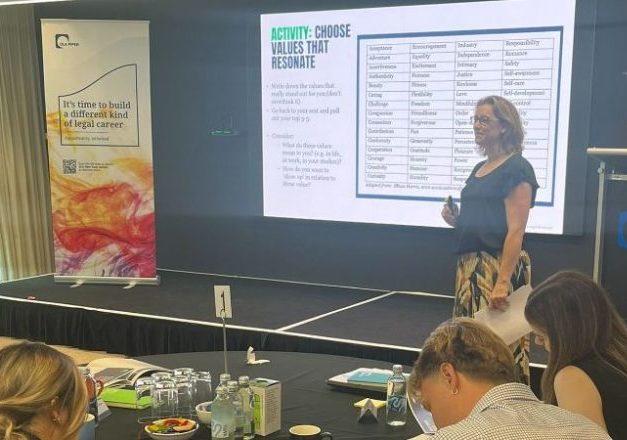How Workplace Mental Health Coaching Transformed a Small Law Firm
Workplace Mental Health Coaching helps businesses create a psychologically healthy workplace and align to their obligations under NSW Work Health and Safety legislation.
When sharing her experience of Workplace Mental Health Coaching, Michelle Oates – founder and Principal Lawyer at Connect Family, a small family law firm – says, “If you’re thinking you don’t have the time [for coaching], you desperately need it.”
For Michelle, the catalyst for coaching was the recognition that she wanted to create a mentally healthy workplace for her employees, while also doing what she needed to do to look after herself as a founder, lawyer and business owner. “If you can’t put on your own oxygen mask, then you’re no good to anyone,” she says.
Before she attended her first session, Michelle acknowledges she was considering selling her business. Now, she says, “Why would I sell this? We are doing something phenomenal here. It was a big, powerful thing for me.”
‘It’s me, hi, I’m the problem’
Michelle laughs, quoting Taylor Swift when asked what surprised her about Workplace Mental Health Coaching.
“I didn’t realise how much of an obstacle I’d become in my own business,” she says. “Not through malintent, but just because the whole business was relying on me. Because that’s how I set it up.”
“I was trying to operate the business as if everything depended on me and I was doing that for them,” Michelle notes. “But as a result, I was not always the nicest person to be around.”
“[Coach] Anna said to me, ‘If your team don’t know where you’re going, how do they know whether they want to follow?”
“Michelle quickly became more aware that because something was clear to her, it didn’t mean it was clear for others,” Anna says.
Playing to strengths
One of the biggest psychosocial risks that Michelle worked through was poor job design – effective work design should be used to eliminate and minimise psychosocial hazards and risks in your workplace.
“Anna said to me, ‘I want you to go ask all the staff, what do they love doing? What’s their why? Why do they get up in the morning?’”
It was this process that led to a discussion with a staff member who was – at that point – looking for other opportunities outside the business. Michelle quickly realised that this team member had a skillset she wanted to retain to support the growth of her organisation.
“She’s now my business development manager, and it’s been amazing,” Michelle says. “It’s a huge shift, and it was just redesigning a role. We didn’t lose her, and she’s never been happier.”
Michelle acknowledges that the conversations around role design would not have happened without coaching.
Coaching can teach effective techniques to open up meaningful conversations with your workers through thoughtful consultation. This approach can help businesses uncover valuable insights and identify solutions that create mutual benefits –potentially enhancing business performance and employee satisfaction.
Consulting and cooperating are an essential part of managing work health and safety risks in your workplace. It’s also a legal requirement under the Work Health and Safety Act 2011.
Coach Anna Kijowska notes that in addition to staff consultation, Michelle was encouraged to reflect on her own role.
“I hate processes and procedures,” Michelle says, acknowledging that she continually stretched herself to work across areas that were, in her own words, “not for her”.
This process led to the employment of a chief operator officer, which has allowed Michelle to focus on her role as Principal Lawyer, and delegate more.
“So instead of everything coming to me, it’s going to the person whose day job it is, and they bloody love it!” she says.
Bringing it all together
Michelle notes that coaching gave her the opportunity to build scaffolding in her workplace and identify blind spots.
“They’re not weaknesses,” she says. “They’re blind spots. And having someone to talk through those who’s not your mum, dad, husband or wife, who always take your side … but someone to hold you to account and say, ‘actually, let’s unpack this some more’ … that’s so important.”
Michelle notes that Anna regularly challenged her to think differently about why she was looking at a particular policy, reviewing a particular practice, communicating a particular way. She adds that Anna helped her see that being vulnerable was OK.
“The flow-on effect is we’ve got really great, open communication within the firm,” she says.
Coach Anna speaks about Michelle’s journey with a great deal of pride, calling her a ‘dream client’.
“In between our last two sessions Michelle did the consultation with the staff, the risk register, put everything in place. She was really able to leverage everything they already had and introduce some new roles and processes, which is really positive too.”
“For me, I got a lot of value from the flow-on effects of coaching,” Michelle says. “I’ve got a lot of value out of understanding who I am as a leader.”
Learn more about Workplace Mental Health Coaching here.
Resources for NSW businesses
Code of Practice: Managing psychosocial hazards at work – practical guidance on the process persons conducting a business or undertaking (PCBUs) could use to identify and to manage psychosocial hazards at work.
Designing Work to Manage Psychosocial Risks – information about how work designs can be used to eliminate and minimise psychosocial hazards and risks in your workplace.



